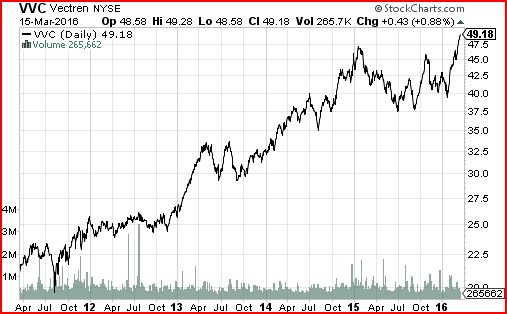Why Dividend-Paying Consumer Stocks Are Worth a Look in This Market
In times like these, the tried and true trump the bold and new.

In case you haven't noticed, there has been a great deal of strength in the stock market during the past month. But the rebound isn’t coming from the market leaders of the past several years. The high-flying growth stocks, especially in the tech sector, and the petroleum and resource stocks that once enjoyed great popularity have let many people down in recent months.
What is holding up well are the mundane stocks that many consider too boring to own, such as food, utilities, and other consumer staples that represent the needs rather than the wants of the population. These are just the type of stocks that we have always highlighted in relation to dividend reinvestment plans (DRIPs), a form of investing that was created out of the strength of well-known consumer brands companies like Procter & Gamble, Colgate-Palmolive and Kimberly-Clark, along with diversified industrials like 3M Company, Boeing and Raytheon. Even in the oil sector, the size and resources of Exxon Mobil make it stand out in sharp contrast to the master limited partnerships (MLPs) that have been decimated.
The stark differences between the tried and true and the bold and new have become obvious and it is the former that is providing comfort to investors while the latter have disappointed.

Sign up for Kiplinger’s Free E-Newsletters
Profit and prosper with the best of expert advice on investing, taxes, retirement, personal finance and more - straight to your e-mail.
Profit and prosper with the best of expert advice - straight to your e-mail.
Even within sectors, the differences are clear. While stocks such as Intel, Microsoft and Cisco have become steady dividend payers (and raisers), popular social networking firms such as Facebook and Twitter have seen their weaknesses exposed. Their reliance on being trendy and new, apparent strengths, can vanish overnight. Whether or not the economy slips into recession, the recent weaknesses in the stock market have made it clear that investors need to pay more attention to the differences in these two worlds: the ethereal world of overnight popularity and the tangible world of long-term success created by companies that provide for basic needs.
Our current stock recommendation is Vectren Corp. (symbol VVC). The company was formed when Indiana Energy, which was founded in 1912, merged with SIGCORP in March 2000. It operates in about two-thirds of Indiana, as well as west central Ohio, serving more than one million natural gas and 144,000 electricity customers, and logs about $2.5 billion in annual revenues. Its non-utility group operates in three segments: energy marketing and services; coal mining; and energy infrastructure services. According to Yahoo Finance, consensus estimates call for the company to earn about $2.52 per share this year, up from $2.39 in 2015, and to go on to net about $2.71 per share in 2017. In October, the board of directors approved a boost in the quarterly dividend, from 38 cents to 40 cents per share, marking the 56th consecutive annual increase and providing a 3.3% yield.

What makes Vectren so attractive is that it provides basic natural gas and electric services to a very stable population base in the Midwest, where regulators have been willing to allow reasonable rate increases and a steady rate of return. That has translated into one of the longest streaks of annual dividend increases in the entire country, which shows no sign of ending soon.
The strength of the earnings and dividend growth rests on the simple fact that Vectren provides necessities in the form of heat and electricity that people will pay for no matter what the state of the economy. Even during the most stressful times of recession, utility bills must be paid (and government assistance is generally available to low-income families and individuals, if needed). Although the company lists non-regulated segments such as energy marketing and coal, that part of its business does not create a severe drag on earnings, since it is relatively small in size.
Vectren is just one of a long list of tried and true companies that have routinely raised their dividends year after year. And many of these companies offer investors the opportunity to invest directly in their company-sponsored DRIP without paying any broker commissions or fees of any kind. Here’s a complete listing of No-Fee DRIPs that have raised their dividend payouts for 25+ years.
Ms. Vita Nelson is one of the earliest proponents of dividend reinvestment plans (DRIPs) and a knowledgeable authority on the operations of these plans. She provides financial information centered around DRIP investing at www.drp.com and www.directinvesting.com. She is the Editor and Publisher of Moneypaper's Guide to Direct Investment Plans, Chairman of the Board of Temper of the Times Investor Service, Inc. (a DRIP enrollment service) and co-manager of the MP 63 Fund (DRIPX).
Get Kiplinger Today newsletter — free
Profit and prosper with the best of Kiplinger's advice on investing, taxes, retirement, personal finance and much more. Delivered daily. Enter your email in the box and click Sign Me Up.

-
 Which Generation Pays the Most Taxes in the US?
Which Generation Pays the Most Taxes in the US?Tax Burden Polls show that most people feel like taxes are unfair. But which age group bears the brunt of the tax burden in the United States?
By Kelley R. Taylor
-
 How Much Will Car Prices Go Up With Tariffs?
How Much Will Car Prices Go Up With Tariffs?Tariffs could drive car prices up even higher, for new and used cars, as well as for American brands.
By Jim Patterson
-
 A QLAC Does So Much More Than Simply Defer Taxes
A QLAC Does So Much More Than Simply Defer TaxesHere are the multiple ways you can use a QLAC, from managing retirement risks to creating income for specific retirement needs and wants.
By Jerry Golden, Investment Adviser Representative
-
 Self-Directed Brokerage Accounts: Retirement's Hidden Gem?
Self-Directed Brokerage Accounts: Retirement's Hidden Gem?SDBAs are often overlooked, but they can offer more flexibility and growth potential inside your 401(k) when actively managed by a professional.
By Scott M. Dougan, RFC, Investment Adviser
-
 Early-Stage Startup Deals: How Does a SAFE Work?
Early-Stage Startup Deals: How Does a SAFE Work?Investing in an early-stage startup can get complicated fast, so the venture capital industry turns to other investing options. One is a SAFE.
By Murat Abdrakhmanov
-
 Should You Hire a Public Adjuster for Your Insurance Claim?
Should You Hire a Public Adjuster for Your Insurance Claim?As natural disasters strike more often, insurance clients are asking, 'What should I do, or who should I hire, if my insurance company is jerking me around?'
By H. Dennis Beaver, Esq.
-
 Tips to Help Entrepreneurs Create Self-Sustaining Businesses
Tips to Help Entrepreneurs Create Self-Sustaining BusinessesWith the right processes and people in place, a truly sustainable business can be efficiently passed on to a successor and run profitably on its own.
By Jason L Smith, CEP®, BPC
-
 Navigating Annuity Taxation: A Guide for Financial Advisers
Navigating Annuity Taxation: A Guide for Financial AdvisersUnderstanding the essentials of taxation in retirement income strategies involving annuities helps ensure positive outcomes for clients.
By Jake Klima
-
 How Google Reviews Can Help (or Hurt) Financial Advisers
How Google Reviews Can Help (or Hurt) Financial AdvisersDon't leave your Google Business Profile unclaimed — someone else can make changes if they claim it. Also, here's what you can (and cannot) do with the reviews.
By Jeff Briskin
-
 How Baby Boomers and Gen Xers Are Redefining Retirement Living
How Baby Boomers and Gen Xers Are Redefining Retirement LivingBoth generations need to embrace change and leverage real estate as a dynamic asset in their retirement planning. Here's how financial advisers can help, too.
By David Conti, CPRC